#black and yellow lichen moth
Text
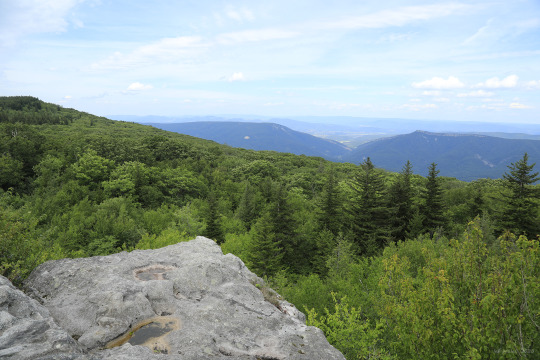
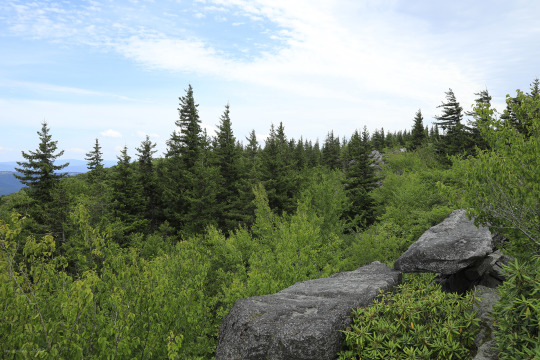



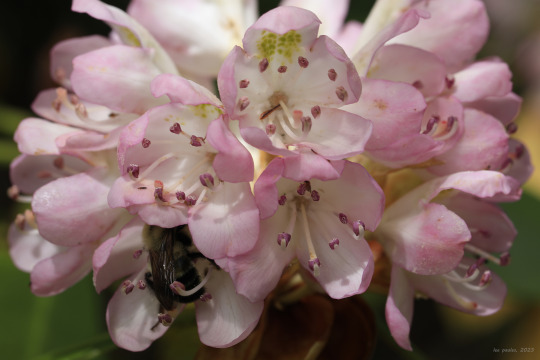

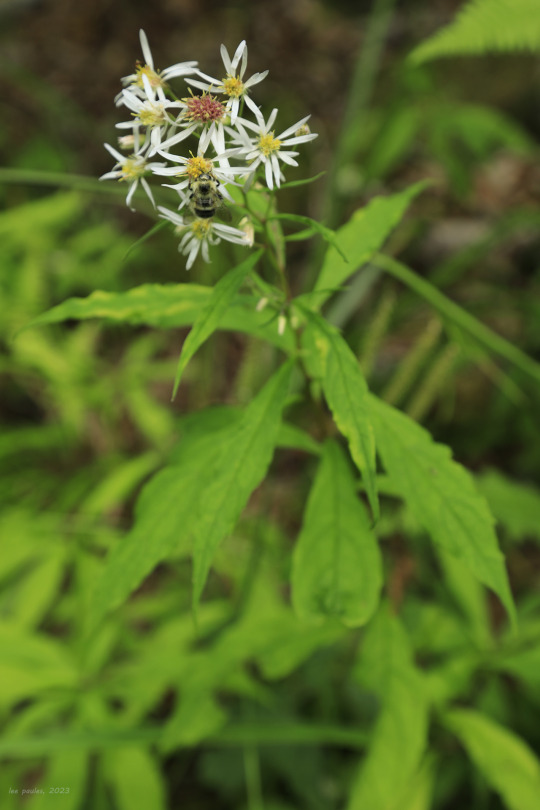





Hazy mid-summer day on the Sods, Part 2.
The planet's fantastic life energy reaches its peak in mid to late summer as the sun's precious light shrinks by the day and every living thing senses its time is running out. On the Plains of Dolly Sods, where the growing season is already compressed by the high elevation, plants compete for the swirling, buzzing masses of insects with their gaudy blooms and produce successive waves of berries to seed new generations. The drone of the insects carrying out their instinctive missions of renewal is constantly in your head as they dive and dart and skirt around you. You barely register as a distraction against the great drama playing out here - one whose stakes are survival, regeneration, salvation. I feel so privileged to have connected with this life force in the most intimate way, even for the few short years of my mayfly existence. I will die a happy man for having immersed myself in its lovely, purposeful chaos and becoming part of something much greater than myself.

#appalachia#vandalia#west virginia#wildflowers#flora#summer#allegheny mountains#monongahela national forest#dolly sods#common milkweed#great spangled fritillary#silver spotted skipper#great rhododendron#rosebay rhododendron#whorled aster#white snakeroot#black and yellow lichen moth#arabesque orb weaver#fireweed#mountain holly#catberry holly#spider#butterfly#moth#lepidoptera#bumblebee
74 notes
·
View notes
Text
Moth of the Week
Dew Moth
Setina irrorella

Photo credit
The dew moth is a part of the family Erebidae. It was first described in 1758 by Carl Linnaeus. It is thought to have gotten its common name from how the moth hangs from a blade of grass or a leaf when resting during the day. This gives it a transparent look.
Description This species’s wings can vary in colour from cream to yellow. The forewing has 3 lines of black dots across it with the hindwing usually having only one black dot. The underside of the forewing is gray with a yellow margin. The body is black with yellow or black legs.
There are many found variations of this moth:
signata Borkh. - the middle rows of spots are connected by streaks
ab. fumosa Sandb. - has brownish ground colour; found in the north, but also found in Germany.
flavicans Bdv. - has brighter deep yellow wings and the apex of the abdomen is yellow; found in the Mediterranean and Anterior Asia.
nickerli Rebel - paler yellow, the forewing slightly dulled with the exception of the clearer yellow inner margin; found in the Alps and Northern Europe.
andereggi H.-Schiff. - has dark veins on the forewings, appearing like rays; found in the high Alps, and in the higher North.
riffelensis Fall. - considerably smaller, the ground colour is slightly dulled, the black vein-streaks are more numerous, especially the costa and median veins strongly sooty black; found in the high Alps, especially abundant above Zermatt.
lata Christ. - larger with broader wings and paler with very few markings, the hindwing often quite without markings; found in Russia over North Siberia to Kamtschatka.
insignata Stgr., - quite similar to the preceding, but with narrower wings. The forewing also with very few dots, and hindwing without any; found in East Siberia.
Wingspan Range: 27 – 33 mm (≈1.06 - 1.30 in)
Forewing Range: 11 – 18 mm (≈0.43 - 0.71 in)
Diet and Habitat The larva of this moth eat only lichen.
This moth is found in the Palearctic region. Its range starts from Ireland, then spreads south through Europe and east to northern and Central Asia. It can be found in countries such as Siberia, Kamchatka, Chukotka, and northern Mongolia. This species can even live in the limestone Alps up to 2,000 meters above sea level. However, it can not be found in the high north and parts of the Mediterranean region.
It prefers to live in mossy and lichen-covered rock corridors, on chalky and sandy areas and steep, rocky sparse grasslands, rocky coasts, shingle beaches, and calcareous grassland inland. It can also be found in bogs, forest meadows, and on heaths.
Mating Depending on location, this moth can be seen from May to July. It presumably mates during this time. Generations per year not listed.
Predators Not listed. However, the adult males fly in the afternoon, at dusk, after dark, and at dawn. The females are largely nocturnal. These moths are presumably preyed on by nighttime predators such as bats.
Fun Fact The dew moth has four subspecies:
Setina irrorella irrorella
Setina irrorella freyeri (Nickerl, 1845)
Setina irrorella insignata (Staudinger, 1881)
Setina irrorella mediterranea (Daniel, 1964)
Additionally, dew moth caterpillars do not cocoon in trees or foliage but rather in between stones or rocks.
(Source: Wikipedia, Butterfly Conservation)
#libraryofmoths#animals#bugs#facts#insects#moth#lepidoptera#mothoftheweek#Setina irrorella#dew moth#Erebidae
79 notes
·
View notes
Text
I Got bored one time awhile ago and made a list of every prefix plus some into organised sections so I thought I might as well share.
All the ones that aren’t cannon to warriors, yet at lest are bold
Describing names
Colours: red, russet, copper, golden, amber, yellow, green, blue, violet, pink, white, gray, black, ebony, dark, pale, silver, brown, tawny, fallow
Pattern, Texture + Size: spot/ted, dapple, speckle, freckle, brindle, patch, mottle, ragged, tangle, kink, bristle, fuzzy, curl/y, wooly, soft, sleek, little, tiny, small, slight, short, tall, long, big, heavy, crooked, broken, half, stumpy, shred, torn, jagged
Actions + Character: flip, pounce, bounce, jump, hop, crouch, down, low, drift, flail, strike, running, fidget, mumble, whistle, snap, sneeze, shiver/ing, shining, flutter, fallen, lost, rush, fleet, quick, shy, sweet, brave, loud, quiet, wild, hope, wish,
Other: claw, whisker, dead, odd, one, spike, fringe, echo, song, hallow, haven
Elements
Time + Weather: day, night, dusk, dawn, morning, sky, sun/ny, moon, storm, lightning, thunder, cloud/y, mist/y, fog, snow, blizzard, ice, frost, dew, drizzle, rain, clear, wind, breeze, gale, shadow, shade, bright, light,
Earth/Water/Fire names: stone, rock, boulder, slate, flint, pebble, gravel, sand/y, dust, mud/dy, meadow, hill, rubble, river, ripple, whorl, float, rapid, shimmer, lake, swamp, marsh, wave, wet, bubbling, splash, puddle, pool, creek, fire, flame, flicker, flash, blaze, scorch, ember, spark, ash, soot, cinder, smoke
Plants
Trees: alder, aspen, birch, beech, cedar, cypress, pine, elm, willow, oak, larch, maple, bay, rowan, timber, bark, log, wood, twig, acorn, cone, seed, spire
Berry/Nut/Fruit/Herb: juniper, elder, sloe, holly, yew, mistle, bramble, hickory, hazel, chestnut, nut, apple, cherry, cranberry, olive, pear, plum, peach, chive, mint, fennel, sage, basil, mallow, parsley
Flowers: aster, poppy, primrose, rose, bluebell, marigold, tansy, pansy, briar, cherry, daisy, dandelion, daffodil, tulip, violet, lily, myrtle, thrift, yarrow, heather, lavender, blossom, bloom, flower, petal
Other: leaf, frond, fern, bracken, sorrel, hay, rye, oat, wheat, cotton, reed, pod, cinnamon, milkweed, grass, clover, weed, stem, sedge, gorse, furze, flax, nettle, thistle, ivy, moss, lichen, bush, vine, root, thorn, prickle, nectar
Animals
Mammals: mouse, rat, mole, vole, shrew, squirrel, hedgehog, bat, rabbit, hare, ferret, weasel, stoat, mink, marten, otter, hog, wolf, hound, fox, vixen, badger, deer, doe, stag, fawn, sheep, cow, pig, lion, tiger, leopard, lynx, milk
Birds: robin, jay, cardinal, thrush, sparrow, swallow, shrike, starling, rook, swift, dove, pigeon, crow, raven, duck, goose, heron, wren, finch, swan, stork, quail, gull, lark, owl, eagle, hawk, kestrel, buzzard, kite, hoot, feather, bird, egg, talon
Fish, Reptiles + Amphibians: pike, perch, pollack, trout, tench, cod, carp, bass, bream, eel, minnow, fin, snake, adder, lizard, turtle, frog, toad, newt
Bug type Names: bug, lady or ladybug, moth, spider, ant, snail, slug, beetle, bee, wasp, dragon or dragonfly, bumble, worm, maggot, cricket, fly, midge, web, honey
Skyclan + Warriorclan: Bella, Billy, Big, Harry, Harvey, Snook, Ebony, Monkey
71 notes
·
View notes
Text
Warrior cat name Ideas
Prefixes - A-Z
A
Acorn
Adder
Amber
Ant
Apple
Arch
Arrow
Aspen
Ash
Asher
Alder
Amber
B
Badger
Bark
Beech
Bellow
Birch
Berry
Bird
Black
Blizzard
Brave
Breeze
Bright
Brown
Bell
Bug
Beetle
Bluebell
Blue
Bounce
Brindle
Brush
Bush
Buzzard
Buzz
Bee
Bumble
Bass
Basil
Bubble
Brine
Beaver
Bison (I feel like this only goes good with ‘horn’ or Bisonpelt/fur.)
Bat
Bone
Butterfly
Burdock
Broken
Bramble
Bracken
Bay
Brisk
Blossom
Briar
Boil
Branch
Bud
C
Cloud
Cloudy
Crystal
Cold
Cricket
Cliff
Cardinal
Crying
Cougar
Coyote
Cobweb
Chick
Cow
Cave
Cheetah
Carrot
Coral
Cactus
Claw
Cedar
Cherry
Cinder
Clover
Copper
Creek
Crooked
Crouch
Crow
D
Dew
Dewy
Duck
Dusty
Dust
Dune
Down
Dagger
Dodge
Dolphin
Daisy
Doe
Dapple
Dappled
Dark
Dawn
Dead
Dove
Drift
Dusk
E
Eagle
Ebony
Echo
Egg
Eel
Ember
F
Fallen
Fallow
Fawn
Feather
Fennel
Fern
Ferret
Finch
Fire
Flame
Fleet
Flint
Flower
Flow
Fly
Fox
Freckle
Frog
Frost
Furze
Fuzzy
Foal
Falling
Fall
G
Gale
Gust
Golden
Gold
Goose
Gorse
Gorge
Grass
Gray
Green
Grass
Goldfish
Guppy
Ghost
H
Hail
Half
Hare
Hawk
Hay
Hoot
Hazel
Heather
Heavy
Hollow
Holly
Honey
Honeycomb
Hummingbird
Horse
Happy
Hornet
Hound
Heron
I
Ice
Ivy
J
Jagged
Jay
Joy
Jaguar
Jackdaw
Jump
Juniper
K
Kestrel
Kink
Koi
L
Lake
Larch
Leaf
Lark
Leopard
Lichen
Lightning
Lily
Lion
Little
Lizard
Log
Long
Lost
Loud
Low
Lynx
M
Maggot
Mallow
Maple
Marsh
Meadow
Milk
Minnow
Mint
Mist
Misty
Mole
Moon
Morning
Moss
Mossy
Moth
Mottle
Mouse
Mouth
Mud
Mumble
Mink
Muddy
Moonlight
Mountain
Mushroom
Monkey
N
Nettle
Needle
Nut
Newt
Night
Nimble
O
Oak
Oat
Odd
Olive
One
Otter
Owl
Orange
Ocean
Orca
Opal
P
Pale
Perch
Pool
Pike
Peak
Prickle
Pounce
Pine
Petal
Petal
Pebble
Pear
Patch
Pirate(kittypet or loner)
Polar
Peach
Panda
Pond
Pigeon
Plum
Q
Quail
Quick
R
Rabbit
Rain
Ragged
Rat
Rattle
Root
Raspberry
Reed
Red
Robin
Rock
Rose
Rowan
Rubble
Running
Rushing
Rush
Russet
Rust
Rye
Raven
Raccoon
Rustle
Rattlesnake
Ravine
Rapid
S
Sage
Short
Sheep
Sedge
Shrew
Slate
Slow
Snail
Sneeze
Sorrel
Soot
Spider
Spruce
Sun
Sunny
Swallow
Shallow
Shade
Sharp
Scorch
Sand
Sandy
Sky
Silver
Smoke
Snake
Soft
Snow
Sparrow
Speckle
Splash
Spotted
Squirrel
Stalking
Stalk
Stalker
Starling
Stone
Storm
Stumpy
Stump
Sweet
Swift
Shred
Sloe
Shell
Seed
Shimmer
Shimmering
Skunk
Spirit
Squid
Shy
Sound
Summer
Sapphire
Spiraling
Spiral
Shark
Saturn
T
Tall
Talon
Tooth
Timber
Tiger
Twig
Tumble
Thorn
Thistle
Thrush
Tawny
Tangle
Ting
Trout
Torn
Toad
Tiny
V
Vine
Vixen
Void
Vole
W
Wasp
Weasel
Web
Weed
Wet
Whisker
White
Whale
Wild
Willow
Wind
Wolf
Winter
Wisteria
Whisper
Whispering
Water
Wave
Waver
Whisper
Watermelon
Whistle
Wood
Y
Yellow
Yew
Yarrow- suggested
You guys DONT WANNA KNOW how LONG this took. I’m crying. And I might’ve missed some so feel free to send me messages in chat to request me editing it and putting it in some (not like messaging but the. Chat in this post lol.)
@cryptidclaw I also did this for our Au to help us with renaming.
I will get to suffixes soon I promise.
123 notes
·
View notes
Text

[PHOTO TAKEN: MAY 30TH, 2023 | Image ID: A black-and-yellow lichen moth, a black moth with yellow/orange markings on its wings, on a dirty white metal surface /End ID.]
I almost had this guy (Lycomorpha pholus) confused for an end band net-wing beetle (Calopteron terminale)! Which makes sense, given they're thought to mimic lycid beetles-
#Moths#Moth#erebidae#hymenoptera#insects#insect#bugs#bug#bugblr#entomology#arthropods#invertebrate#photos#photo#Wasp House Sights
24 notes
·
View notes
Photo




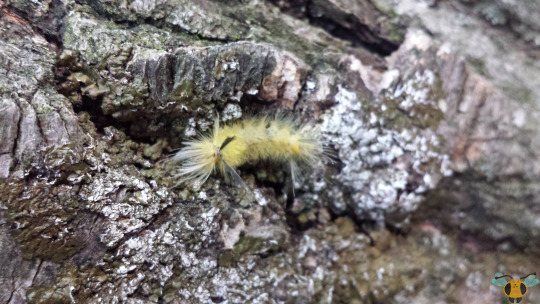
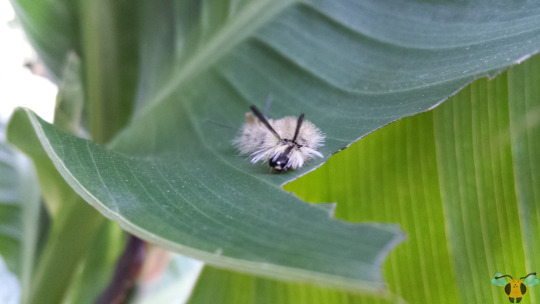
Banded Tussock Moth Caterpillar - Halysidota tessellaris
Though our new fuzzy friend is called a “Tussock Moth”, it is not actually a true Tussock Moth. Indeed, insect naming isn’t exactly one-to-one, but the nomenclature usually has a logic behind the choice. For this particular specimen, the name tussock comes from the coat of fuzz and fibers that line its body. In all fairness, it does look similar to other Tussock Caterpillars thanks to the fluff and spines (for example, compare it to the White-Marked Tussock Caterpillar), but that being said, this particular Caterpillar is sorted among the Tiger Moths (means it’s closer in relation to our Woolly Bear friends). Not to get into the nitty-gritty, but while both the Banded Tussock and other Tussock Moths belong within the Erebidae family of Moths (it’s a VERY big family), our showcase today belongs to the subfamily Arctiinae (Tiger and Lichen Moths) and the Tussock Moths belong the subfamily Lymantriinae. So yes, it’s the same tree with different branches, and today’s insect is one of the Tiger Moths contrary to what the name would suggest. Since it isn’t a Tussock Moth, the bristles across its body may not be as irritating as one might expect.
Now that I know what to look for with this specie, I may allow the next one I find to crawl on my hand to see what, if anything happens. I do still strongly advise caution against handling of spined Caterpillars (unless positively identified) due to the risk of rash or allergic skin reaction. I would also DEFINITELY advise against directly picking them up as those spines (particularly the dark ones behind the head) are there for a reason: a prickly deterrent against birds or rodents! On a more positive note, as a Tiger Moth, you can expect vibrant coloration on both the adult Moth and the fuzzy Caterpillar. The Moths feature pale wings with patterning separated by black lines, thin golden legs and antennae, a bright yellow abdomen, and a yellow thorax with two streaks of blue fur. Most vibrant! The young Caterpillars begin with lovely colors too: starting off a bit pale and gradually acquiring more vibrant colors as they grow from instar to instar. The color ranges from white to yellow and even shades of brown, which sounds very similar to our fluffy Virginian Tiger Moth Caterpillar friends. Maybe it has something to do with their diets, but since the Banded Tussock is a generalist of forest tree leaves, I wouldn’t even know where to begin.
Pictures were taken on August 26, 2019 in Collingwood with a Samsung Galaxy S4.
#jonny’s insect catalogue#ontario insect#caterpillar#banded tussock moth caterpillar#banded tussock moth#moth#insect#collingwood#2019#august2019#entomology#nature#invertebrates
16 notes
·
View notes
Text
This morning sucked but then my mom sent me this picture of a beautiful moth on her car:

And now I have a new favorite moth and am obsessively researching it so that's a nice development :)
It's a black and yellow lichen moth if anyone else sees this beautiful friend and also goes !!!!!!!!!!!!!!! like I did and wants to learn more.
2 notes
·
View notes
Text
#1814 - Anestia ombrophanes - Clouded Footman (a family portrait)

I’ve posted a photo of the adult male, before, WAY back, but here’s a photo that includes most stages of their lifecycle.
Clouded Footman moths can have wings, if they’re male, or be big grey fuzzy sausages if they’re female. That’s the female at the left. She’s wingless, and will lay her eggs on the cage she built from her own hair, back when she was a caterpillar ready to pupate. That’s the cage the two adults are sitting on, and she’s already laid quite a few. Inside the cage you can not only see her cast-off caterpillar skin the shrivelled dark object at right), but also her empty pupal case.
The caterpillars are black with a complex pale yellow pattern on each segment, including two thin pale yellow lines running the length of the body. They also have a row of orange spots along each flank, and bundles of long fine hair pointing in most directions. It’s those hairs that the caterpillar will weave into a protective cage. They eat lichen, green single celled algae, and black cyanobacteria of the kind that grow of exposed rocks, roof shingles, and so on.
Spotted on the wall of my local games store. They certainly have drainage problems on their roof (it’s been the cause of repeated flooding inside the store itself) so I wouldn’t be surprised if that’s where the caterpillars were feeding.
204 notes
·
View notes
Photo
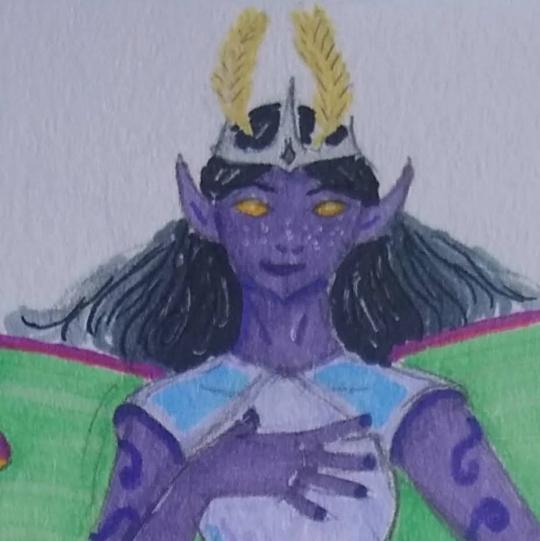
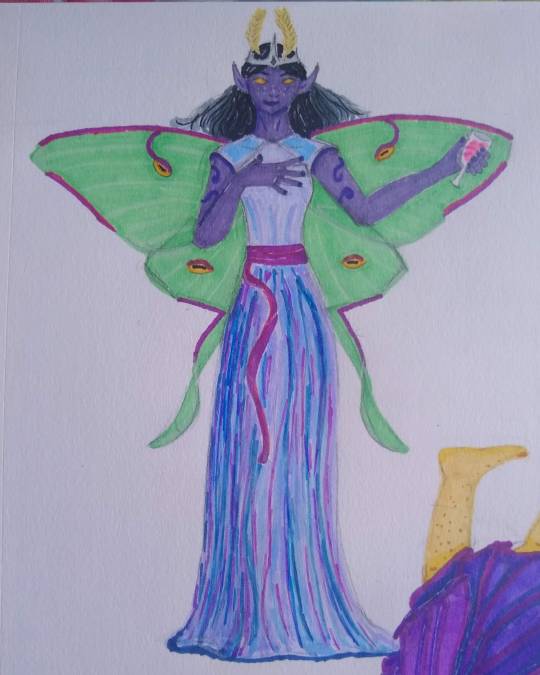


Queen Titania and Lord Oberon of the Seelie Court
The guards march her up the front steps of the palace, through the towering columns, and through the throng of gawking fae. Hannah can scarcely watch the crowd’s reaction before they spin away in a mad dance. She can’t tell if it’s a Masquerade, or if the faces adorned with lichen and greenery are naturally like that. Each one plays the phantom, and she the unwitting attendant. The music soars and twists into impossible shapes, a lively melody that winds around her and pulls her into the intoxicating revelry. She resists the urge to twirl in time with the tune and claps her hands over her ears. If she begins dancing, she will not stop. For the first time, she is thankful for her guards pulling her on ever forward to her destination. What if the Piper is here? With his pallid visage and colorful clothes, he’d fit right into the motley crowd.
As she enters the throne room, she wonders if maybe she shouldn’t be thankful, as they bring her to yet another trial. A throne stand atop a raised dais in a semi-circular room. Servants hurry to bring trays of food to their monarchs. The queen sits distinguished in a silvery celestial gown and enjoys delicacies, dropping no fruit on her dress. She has a wild look in her large golden eyes, and her skin marbles indigo and violet Black hair spills over her shoulders like clouds of ink. Her wings are like a Luna moth’s, huge and pale green, and she holds a glass of chocolate wine just in danger of tipping over.
If the queen embodies the night, the king personifies the day. He sprawls across her lap, leaning casually sideways across the throne they share. Dark freckles stand out like sunspots on pale yellow skin. A tousle of golden curls frames his face. He wears a crown made from a wreath of ivy. His wings are like a monarch butterfly’s—how fitting, thinks Hannah with a wry internal laugh. He wears a plum-colored robe and sandals that dangle from his feet. One hand holds a glass of sparkling champagne, and the other, a leg of meat. He laughs with an attendant, and his dark eyes flash with enjoyment.
“Now what do we have here?” hums the queen.
#runaways#etta's art#faebruary#queen titania#lord oberon#lets see if tumblr lets me post this I've tried THREE TIMES now smh
18 notes
·
View notes
Note
what are qilik dyes made out of? do they have special access to any colors (like purple) that are hard to come by in the rest of the world?
very broad question but i actually have some lore on dye since its MEGA important to most qilik peoples.
the czekil people specifically hail from a temperate grassland/forest region and the majority of their homegrown dyes are plant-based, with a few being pigments from beetles and moths.

the yellows here are likely sourced from snake-weed, onionskins and/or welds primarily
the GREENS here are actually very rare. the dark greens are likely produced by mixing black dyes with yellow, while the bright greens (that arent imported) are mainly sourced from beetles, though lichens might be used.
the reds-oranges are probably based in sumac and yellow dyes
35 notes
·
View notes
Text
Prefixes
Black
Ant
Auk
Avocet
Badger
Bat
Beetle
Black
Blackthorn
Boar
Chough
Coal
Coot
Cormorant
Crow
Dark
Diver
Dogwood
Ebony
Eider
Elder
Fly
Grebe
Grouse
Ivy
Jackdaw
Lapwing
Loon
Magpie
Martin
Mole
Moorhen
Night
Petrel
Plantain
Privet
Puffin
Rat
Raven
Rook
Scorch
Scoter
Sedge
Shade
Shadow
Sheep
Sloe
Slug
Soot
Spider
Star
Starling
Starry
Swallow
Swift
Gray
Anemone
Ash
Aspen
Aster
Bass
Birch
Bitterling
Blackthorn
Bleak
Blizzard
Blue
Bluebell
Boulder
Box
Bream
Burdock
Char
Chicory
Chive
Cinder
Clear
Cloud
Cloudy
Coal
Comfrey
Crane
Crocus
Cuckoo
Dace
Dark
Dawn
Dew
Dewy
Diver
Dove
Drizzle
Dunlin
Dusk
Evening
Falcon
Fir
Flax
Flint
Fly
Fog
Fumitory
Gadwall
Godwit
Goose
Gravel
Gray
Gull
Hail
Harrier
Heather
Heron
Hoar
Hornbeam
Indigo
Iris
Ivy
Jackdaw
Juniper
Kingfisher
Knot
Lake
Larkspur
Lavender
Lichen
Lilac
Mallard
Mayfly
Merlin
Minnow
Mint
Mist
Misty
Mole
Moon
Moth
Murk
Nettle
Nuthatch
Ocean
Orchid
Pale
Pansy
Partridge
Pebble
Perch
Petrel
Pigeon
Pike
Pine
Pintail
Plantain
Pond
Pool
Poplar
Puddle
Rain
Rill
Rime
Ripple
River
Roach
Rock
Rosemary
Saffron
Sage
Salmon
Scale
Scree
Shade
Shadow
Shell
Shimmer
Shine
Shining
Shrike
Silver
Sky
Slate
Sleet
Slug
Smelt
Smoke
Soot
Squill
Squirrel
Star
Starry
Stone
Storm
Stream
Sycamore
Teal
Teasel
Tempest
Tern
Thistle
Thrift
Thyme
Tussock
Vervain
Violet
Wave
Wet
Willow
Wisteria
Wolfsbane
Brown
Acorn
Adder
Alder
Ant
Avens
Bark
Barley
Bat
Beaver
Beech
Beetle
Bittern
Blenny
Boar
Boulder
Bracken
Bramble
Brambling
Branch
Briar
Brown
Bunting
Buzzard
Carp
Cedar
Chestnut
Chub
Copper
Cricket
Curlew
Cypress
Deer
Dipper
Doe
Duck
Dunlin
Dunnock
Dusk
Dust
Dusty
Eagle
Eel
Egg
Eider
Elm
Fallow
Fawn
Frog
Grass
Grasshopper
Gravel
Grebe
Grouse
Gudgeon
Hare
Harrier
Hawk
Hazel
Hedgehog
Hobby
Honey
Hop
Ivy
Jay
Kestrel
Kite
Lamprey
Larch
Lark
Leaf
Lichen
Limpet
Linnet
Lizard
Loach
Log
Loon
Mallard
Marten
Mayfly
Mink
Minnow
Mole
Mosquito
Moth
Mouse
Mud
Muddy
Muntjac
Nerite
Nest
Newt
Nightingale
Nut
Oak
Oat
Osprey
Otter
Owl
Partridge
Pebble
Perch
Pheasant
Pike
Pintail
Piper
Pipit
Plover
Ptarmigan
Quail
Rabbit
Rail
Rat
Reed
Robin
Rock
Root
Rudd
Rush
Russet
Rye
Scorch
Scoter
Scree
Sedge
Seed
Shell
Shoveler
Shrew
Snail
Snake
Snipe
Sparrow
Spider
Spruce
Stag
Swift
Tan
Tawny
Teasel
Thorn
Thrush
Tiger
Timber
Toad
Tree
Trout
Tussock
Twig
Twite
Vole
Warbler
Weasel
Weed
Weevil
Whimbrel
Whinchat
Wood
Wren
Yew
Ginger/Red
Agrimony
Alder
Amber
Ant
Apple
Asphodel
Avens
Balsam
Bee
Blaze
Brambling
Bumble
Bumblebee
Burnet
Buttercup
Campion
Chanterelle
Cherry
Copper
Cypress
Daisy
Dandelion
Dawn
Fire
Flame
Fox
Fritillary
Gannet
Ginger
Hawthorn
Heather
Holly
Honey
Honeysuckle
Hornet
Laburnum
Leopard
Lettuce
Lion
Maple
Marigold
Morning
Nuthatch
Onion
Parsnip
Peach
Pear
Pepper
Plum
Poppy
Raspberry
Red
Robin
Rose
Rowan
Ruddy
Russet
Sand
Sandy
Scorch
Skipper
Sorrel
Spindle
Squirrel
Stoat
Strawberry
Sun
Sunny
Tan
Tawny
Thrift
Tiger
Tip
Valerian
Vixen
Wasp
Whitebeam
Wisteria
Yarrow
Yellow
Yew
Golden/Cream
Acorn
Agrimony
Amber
Apple
Asphodel
Balsam
Bee
Bryony
Bumble
Bumblebee
Buttercup
Carp
Chanterelle
Cheetah
Clear
Clover
Daffodil
Daisy
Dandelion
Dogwood
Egg
Elder
Fennel
Fritillary
Furze
Gannet
Gold
Golden
Gorse
Honey
Honeysuckle
Hornet
Laburnum
Larch
Leopard
Lettuce
Light
Lightning
Linden
Lion
Mallow
Maple
Milk
Mistletoe
Morning
Nectar
Oat
Parsnip
Pheasant
Poplar
Primrose
Reed
Rue
Rush
Rye
Sand
Sandy
Seed
Sheep
Sun
Sunny
Tansy
Tawny
Thorn
Tulip
Wasp
Wax
Weed
Yellow
White
Anemone
Angelica
Apple
Balsam
Blackthorn
Blizzard
Bright
Bryony
Campion
Caraway
Celery
Chamomile
Cherry
Chervil
Cicely
Cilantro
Clear
Cloud
Cloudy
Clover
Comfrey
Coriander
Cotton
Cress
Daisy
Dandelion
Dogwood
Egg
Egret
Elder
Flurry
Frost
Garlic
Gleam
Glimmer
Hawthorn
Hemlock
Holly
Honeysuckle
Ice
Laurel
Leek
Light
Lightning
Lily
Mallow
Milk
Mistletoe
Myrrh
Onion
Pale
Parsley
Pear
Plum
Primrose
Privet
Rime
Saffron
Sheep
Shell
Shine
Shining
Sloe
Snow
Snowdrop
Snowy
Spignel
Star
Starry
Strawberry
Swan
Valerian
Violet
White
Whitebeam
Wisteria
Yarrow
Bicolor
Auk
Avocet
Badger
Brambling
Bunting
Buzzard
Bright
Chub
Cuckoo
Dipper
Diver
Duck
Dunlin
Eel
Eider
Falcon
Godwit
Gudgeon
Gull
Hawk
Heron
Hobby
Knot
Lamprey
Lapwing
Leech
Lizard
Loon
Magpie
Marten
Martin
Merlin
Moth
Mouse
Nerite
Osprey
Otter
Pansy
Patch
Petrel
Pintail
Piper
Pipit
Plover
Poplar
Ptarmigan
Puffin
Quail
Robin
Sheep
Shrike
Sky
Snipe
Sparrow
Splash
Stoat
Swallow
Teal
Tern
Thrush
Tip
Toad
Twite
Weasel
Tortoiseshell/Calico
Apple
Argus
Bark
Blaze
Blue
Brambling
Bright
Brindle
Brown
Char
Cherry
Cinder
Comma
Copper
Cypress
Dapple
Dappled
Dark
Drizzle
Dusk
Dust
Dusty
Ember
Fallow
Finch
Fleck
Freckle
Fritillary
Gannet
Grebe
Guppy
Kestrel
Kingfisher
Leaf
Beech
Leopard
Lichen
Lizard
Maple
Morning
Moss
Mossy
Moth
Mottle
Mottled
Nerite
Newt
Nuthatch
Pansy
Patch
Pochard
Robin
Shell
Shoveler
Skipper
Sorrel
Speck
Speckle
Splash
Spot
Spotted
Sycamore
Tip
Toad
Trout
Wigeon
Tabby
Adder
Alder
Arch
Ash
Aspen
Bark
Barley
Bass
Bee
Birch
Bitterling
Bittern
Blaze
Bleak
Blenny
Blizzard
Blue
Boulder
Box
Bracken
Bramble
Brambling
Branch
Bream
Briar
Bright
Brindle
Brown
Bryony
Bumble
Bumblebee
Bunting
Burdock
Buzzard
Carp
Cedar
Cheetah
Chub
Cinder
Copper
Cricket
Cuckoo
Curl
Curlew
Curly
Cypress
Dace
Dapple
Dappled
Dark
Deer
Doe
Duck
Dunlin
Dunnock
Dusk
Dust
Dusty
Eider
Evening
Falcon
Fallow
Fir
Fleck
Fly
Freckle
Fritillary
Frog
Gadwall
Goose
Grasshopper
Grebe
Grouse
Gudgeon
Hail
Harrier
Hawk
Hobby
Hornbeam
Hornet
Ivy
Jagged
Juniper
Kestrel
Kite
Lark
Leopard
Lichen
Limpet
Lizard
Loach
Long
Mallard
Marble
Mayfly
Merlin
Minnow
Mist
Misty
Mottle
Mottled
Nerite
Newt
Oak
Osprey
Owl
Partridge
Perch
Pheasant
Pike
Piper
Pipit
Ptarmigan
Quail
Rail
Rain
Reed
Ringlet
Ripple
Salmon
Shell
Shoveler
Silver
Sleet
Slug
Smoke
Snail
Snake
Snipe
Soot
Sorrel
Sparrow
Speck
Speckle
Spider
Spot
Spotted
Stag
Stripe
Striped
Sycamore
Tabby
Teal
Teasel
Tempest
Thrush
Tiger
Toad
Trout
Tussock
Twite
Wasp
Whimbrel
Whinchat
Whorl
Wren
Other Patterns
Blaze
Blue
Bright
Brindle
Brown
Cinder
Copper
Curlew
Cypress
Daffodil
Daisy
Dust
Dusty
Fade
Fallow
Fleck
Freckle
Gannet
Pintail
Rain
Snipe
Speck
Speckle
Spider
Star
Starry
No Particular Color
Arch
Bay
Beach
Berry
Bird
Bloom
Blossom
Bog
Bounce
Brave
Breeze
Bright
Bristle
Brook
Bubble
Bush
Butterfly
Chirp
Claw
Cliff
Coast
Cone
Creek
Crouch
Curl
Curly
Dapple
Dappled
Delta
Dew
Dewy
Down
Downy
Drift
Drizzle
Ebb
Echo
Fade
Fallen
Feather
Fen
Fern
Fidget
Field
Fin
Flail
Flash
Fleet
Flicker
Flip
Flower
Flutter
Forest
Frond
Fuzzy
Gale
Gill
Gleam
Glimmer
Grass
Green
Gust
Heath
Heavy
Hill
Hollow
Hoot
Hope
Jagged
Jump
Lake
Leaf
Little
Loud
Low
Marble
Marsh
Meadow
Mumble
Needle
Ocean
Odd
Petal
Pond
Pool
Pounce
Prickle
Puddle
Quick
Quiet
Rill
Ringlet
Ripple
River
Root
Running
Scale
Scree
Seed
Sharp
Shimmer
Shine
Shining
Short
Shrub
Shy
Sky
Sleek
Slight
Small
Snap
Sneeze
Snip
Soar
Soft
Song
Spot
Spotted
Sprout
Squall
Stem
Stream
Strike
Stump
Stumpy
Swamp
Sweet
Tall
Talon
Tangle
Thorn
Thunder
Tiny
Tumble
Twig
Wave
Web
Weed
Wet
Whisker
Whistle
Whorl
Wild
Wind
Wing
Woolly
4 notes
·
View notes
Text
okay guild of rushing water allegiances for tnp!!!!
lord [cat in charge, has the final say in all decisions] - hollowed oak, the wisest. a large, graying brown tabby tom with pale green eyes.
heir [cat who will take over when the lord dies or retires, the kit of the lord] - serpent. a small, slim sandy tom with green eyes.
council [cats picked by the lord to advice their decisions] -
lichen, the eloquent. a wavy furred cream tabby tom with green eyes.
slate, the fearless. a muscular gray and white tom with amber eyes.
ember, the glorious. a small dark ginger tom with green eyes.
medic [cat who upkeeps the health of the guild] - fawn, the quiet. a pale brown and white tom with bright blue eyes.
den mother [cat who permanently stays in the nursery and guards it] - wave, the powerful. a huge, bulky gray tabby molly with amber eyes.
hunters [cats who provide food for the guild] -
wheat, the fair. a long legged light brown molly with blue eyes.
branch, the little. a tiny brown tabby tom with green eyes.
cloud, the generous. a big, fluffy white molly with blue eyes.
hawk, the courteous. a short furred brown tabby molly with gray eyes.
honey, the kind. a slim, curly furred tom with bright amber eyes.
moss, the brave. a lanky pure white tom with green eyes.
guards [cats who protect the guild’s territory] -
beetle, the tough. a dark brown and white tom with dark amber eyes.
dawn, the beloved. a long haired pale orange molly with green eyes.
wolf, the rash. a scruffy gray and black tom with brown eyes.
spark, the bright. a lean molly with bright ginger fur and yellow eyes.
pebble, the stubborn. a speckled gray and white molly with brown eyes.
fern, the proud. a curly furred white molly with light green eyes.
grass, the restless. a straight haired tom with brown fur and yellow eyes.
scouts [cats who patrol near the guild’s borders] -
brook, the wild. a pale gray-brown tabby molly with amber eyes.
finch, the quick. a light brown and ginger molly with amber eyes.
hare, the bold. a cream and white bicolor tabby tom with green eyes.
willow, the meek. a speckled gray molly with light blue eyes.
breeze, the precious. a brown marbled tabby tom with blue eyes.
laborers [cats who aid in gathering herbs and help upkeep camp] -
rat, the dexterous. a small, gangly pale brown tom with amber eyes.
snail, the observant. a ginger molly with swirling stripes and yellow eyes.
bark, the gentle. a small brown and ginger molly with green eyes.
trainees [cats training to gain a certain rank] -
apple. a bright ginger molly with green eyes.
ripple. a gray tabby tom with blue eyes.
lizard. a dark cream molly with yellow eyes
drizzle. a speckled brown molly with blue eyes.
monarchs [cats who raise kits] -
rain, the softhearted. a light gray tabby molly with light blue eyes. (lamb, a pure white tom. whistle, a brown tabby molly. serpent, a sandy tom)
knoll, the affable. a ginger tabby molly with green eyes. (ivy, a ginger tom. sleet, a white tom)
seed, the just. a small black molly with blue eyes. (ant, a black molly. clover, a black tom)
flutter, the merry. a light brown molly with amber eyes. (moth, a brown tom)
elders [cats too old to hunt or fight] -
toad, the battler. a plump speckled brown tom with amber eyes.
blossom, the loving. a fluffy tortoiseshell molly with yellow eyes.
notes:
they are medieval themed, that will be evident in their ways of life
the guild is rather old fashioned, even with gender roles. the lord and their heir are typically only male. though, mollies can sometimes be chosen for the council
the lord typically takes multiple mates. they MUST have a single male kit in their lifetime
the guild is strong, but never asks for help nor do they wish to help the clans
they are not related to the clans
the guild is not.... supposed to be a good group. their morals and ideals are supposed to be questioned, which is why brook will be exiled and choose not to return. and they are shocked when feathertail, a molly, saves them. they are Meant to be bad ajfjskd
18 notes
·
View notes
Text
Table Rock Lake Clans - List of Prefixes by Color
An exhaustive list of all possible prefixes in the Clans of Table Rock Lake
I may make a category list soon
Black
Ani - derived from the grove-billed ani
Ant - used for small cats
Bat
Bear - used for big cats - derived from the American black bear
Beetle
Black
Bramble - refers to the ripened fruit - derived from the blackberry bramble
Cherry - refers to the fruit - derived from the black cherry
Cicada - used for tabbies
Coal
Coot - derived from the American coot
Cormorant - derived from the double-crested cormorant
Cricket - used for solids or tabbies
Crow
Dark
Duck
Eel - used for long-bodied cats
Evening
Flint
Goose - used for black and white cats
Grackle - derived from the common grackle
Hornet
Loon - used for black and white tabbies - derived from the common loon
Mink - derived from the American mink
Night
Raven
Shade
Shadow
Skunk - used for black tabbies or black and white cats - derived from the striped skunk (tabby) and the spotted skunk (bicolor)
Smoke - used for tabbies
Soot
Spider
Starling
Storm
Swift - used for black and white cats
Turtle
Vulture - derived from the turkey vulture
Wasp
Weevil
Willow - refers to the bark - used for black longhairs - derived from the black willow
Brown
Bat
Bear - used for large brown cats - derived from the grizzly bear
Beaver
Beetle
Bison - used for big cats
Bittern - used for light brown tabbies with white - derived from the American bittern
Brown
Chicken - used for light brown spotted tabbies with white - derived from the prairie chicken
Chipmunk - used for small tabbies
Cricket - used for tabbies
Cougar - used for large light brown cats
Deer - used for light brown cats - derived from the white-tailed deer
Duck
Dust
Eagle - used for brown and white cats - derived from the bald eagle
Elk - used for large cats
Frog - used for spotted tabbies
Grebe - derived from the horned grebe
Grouse - used for spotted brown cats - derived from the ruffed grouse
Harrier - used for brown and white cats - derived from the Northern harrier
Hawk - used for brown and white cats - derived from the red-tailed hawk
Honey - used for golden-brown cats
Lizard - used for tabbies
Mantis
Mink - derived from the American mink
Moth - used for tabbies
Mouse - derived from the house mouse
Mud
Nightjar - used for spotted brown tabbies - derived from the common nighthawk
Oak - refers to the bark - used for tabbies - derived from the black oak
Oat - refers to the flower - derived from the wild oat
Pecan - used for tabbies - derived from the pecan tree
Quail - used for spotted and white tabbies - derived from the bobwhite quail
Rabbit - derived from the cottontail rabbit
Rail - used for dark brown spotted tabbies - derived from the king rail
Rat - derived from the brown rat
Rock
Rush - refers to the flowers - derived from the common rush
Snail
Soil
Sparrow - used for brown and white tabbies - derived from the house sparrow
Spider
Stone
Sycamore - used for big tabbies - derived from the American sycamore
Tawny - used for light brown cats
Teal - derived from the cinnamon teal
Thrush - used for spotted light brown and white tabbies - derived from the wood thrush
Turkey - used for big cats
Turtle
Walnut - refers to the nuts - derived from the black walnut
Weasel - used for brown and white cats - derived from the long-tailed weasel
Weevil
Wigeon - derived from the American wigeon
Wren - used for brown and white tabbies
Reddish-Brown
Alder - refers to the bark - used for tabbies - derived from the hazel alder
Cardinal - refers to the female of the species
Cedar - refers to the bark - used for tabbies - derived from the red cedar
Clay
Crane - derived from the sandhill crane
Ibis - derived from the white-faced ibis
Owl - used for spotted reddish-brown tabby and white cats - derived from the screech owl
Pheasant - used for spotted tabbies - derived from the common pheasant
Gray-Brown
Armadillo - used for tabbies
Bass
Birch - refers to the bark - derived from the river birch
Boulder - used for large cats
Coyote
Dove
Elm - refers to the bark - used for tabbies - derived from the American elm
Hare - derived from the American desert hare
Hickory - refers to the bark - used for tabbies - derived from the bitternut hickory
Kinglet
Lark - used for grayish-brown and white cats - derived from the horned lark
Lynx - used for spotted tabbies - derived from the bobcat
Magnolia - refers to the bark - used for tabbies - derived from the cucumber magnolia
Mole - derived from the Eastern mole
Pike - used for spotted tabbies
Pine - refers to the bark - derived from the shortleaf pine
Sand
Shell - used for tabbies
Vole - derived from the prairie vole
Warbler
Gray
Badger - used for tabbies - derived from the American badger
Bass
Bergamot - refers to the flowers - derived from the plant
Blizzard - used for spotted light gray tabbies
Boulder - used for big cats
Burdock - derived from the greater burdock
Carp
Chickadee - used for small gray and white cats - derived from the Carolina chickadee
Cinder
Coyote
Dark - used for dark gray cats
Dawn - used for light gray cats
Dove
Dusk - used for dark gray cats
Evening
Falcon - used for gray and white cats - derived from the peregrine falcon
Fog
Goose - used for gray and white cats
Granite - used for spotted tabbies
Gray
Gull - used for gray and white cats
Hail - used for light gray cats
Halcyon - used for dark gray or blue cats with a little white - derived from the belted kingfisher
Haze
Henbit - derived from the common henbit
Heron - derived from the great blue heron
Junco - derived from the dark-eyed junco
Larkspur - derived from the delphinium
Lichen - used for light gray tabbies
Lizard - used for tabbies
Lobelia - derived from the great blue lobelia
Loon - used for gray and white tabbies - derived from the common loon
Lynx - used for spotted tabbies - derived from the bobcat
Mallow - derived from the common mallow
Minnow - used for tabbies
Mint - refers to the flowers - derived from the hoary mountain mint
Mist
Mole - derived from the eastern mole
Moth - used for tabbies
Murk - used for dark gray cats
Nettle - derived from the American stinging nettle
Nuthatch - used for gray and white cat
Opossum - derived from the North American possum
Owl - used for large gray and white tabbies - derived from the barred owl
Pale - used for light gray cats
Pebble - used for small cats
Phacelia - derived from the purple phacelia
Phlox - derived from the woodland phlox
Pigeon
Pike - used for spotted tabbies
Raccoon - used for gray tabbies - derived from the common raccoon
Rain
Rock
Sage - derived from the wood sage
Shade - used for dark gray cats
Shale
Shell - used for tabbies
Shrew - derived from the northern short-tailed shrew
Shrike - used for gray and white cats - derived from the northern shrike
Silver
Slate
Sleet - spotted gray tabby
Smoke - used for tabbies
Soot - used for dark gray cats
Squirrel - used for gray and white cats - derived from the eastern gray squirrel
Steam - used for pale gray tabbies
Stone
Storm - used for dark gray cats
Sycamore - used for big light gray tabbies - derived from the American sycamore
Thalia - used for gray and white cats - derived from the powdery thalia
Thistle - derived from the common thistle
Titmouse - derived from the tufted titmouse
Trout - used for spotted tabbies
Vervain - derived from the blue vervain
Vetch - derived from the common vetch
Violet - derived from the birdsfoot violet
Wolf - derived from the gray wolf
Blue
Aster - derived from the flower
Blue
Bunting - derived from the indigo bunting
Chicory - derived from the common chicory
Gallinule - derived from the common gallinule
Glory - derived from the morning glory
Halcyon - used for dark gray or blue cats with a little white - derived from the belted kingfisher
Indigo - derived from the blue false indigo
Jay - used for blue and white tabbies - derived from the blue jay
Swallow - used for blue and white cats - derived from the tree swallow
Ginger/Red
Apple - refers to the fruit - derived from the wild apple
Ash - refers to the leaves - derived from white ash
Bergamot - refers to the flowers - derived from the plant
Blaze
Bramble - refers to the unripe fruit - derived from the blackberry bramble
Cardinal - refers to the male of the species
Dawn
Dusk
Ember - used for small cats
Evening - used for deep red cats
Fire
Fox - derived from the red fox
Ginger
Ginseng - derived from the American ginseng
Hawthorn - refers to the fruit - derived from the red hawthorn
Hazel - refers to flowers - derived from the Ozark witch hazel
Holly - refers to the fruit - derived from the meadow holly
Ivy - used for tabbies - derived from the poison ivy
Maple - refers to the leaves - derived from the red maple
Marigold - derived from the marigold
Morning
Lily - used for spotted tabbies - derived from the leopard lily
Oak - refers to the leaves - derived from the white oak
Persimmon - derived from the American persimmon
Plum - refers to the fruit - derived from the American plum
Pumpkin - refers to the fruit
Red
Spark
Sumac - refers to the leaves or berries - derived from the fragrant sumac (leaf) and the smooth sumac (berry)
Tanger - refers to the male of the species - derived from the summer tanger
Wasp - used for tabbies
Gold/Cream
Amber
Aphid - used for small cats
Apple - refers to the fruit - derived from the wild apple
Bee - used for tabbies
Blaze
Bolt
Daffodil - derived from the narcissus
Daisy - derived from the yellow ox-eyed daisy/black-eyed Susan
Dandelion - refers to the flower - derived from the weed
Dawn
Finch - derived from the goldfinch
Golden
Honey
Hornet - used for tabbies
Lightning
Locust - refers to the leaves - derived from the honey locust
Lotus - derived from the American lotus
Marigold - derived from the marigold
Morning
Mullein - refers to the flower - derived from the great mullein
Mustard - derived from the black mustard
Persimmon - derived from the American persimmon
Poppy - derived from the celandine poppy
Primrose - derived from the common evening primrose
Sand
Spark
Tanger - refers to the female of the species - derived from the summer tanger
Tansy - derived from the common tansy ragwort
Tawny
Velvet - derived from the velvet plant
Yellow
White
Aphid - used for small cats
Apple - refers to the flowers - derived from the wild apple
Avens - derived from the white avens
Bramble - refers to the flower - derived from the blackberry bramble
Blizzard
Bolt
Bright
Cherry - refers to the flowers - derived from the black cherry
Cloud
Clover - refers to the flowers - derived from the white clover
Cohosh - derived from the black cohosh
Cotton - refers to the seeds - derived from the upland cotton
Dandelion - refers to the seeds - derived from the weed
Egret - derived from the snowy egret
Flax - derived from the bastard toadflax
Frost
Gaura - derived from the gaura flowers
Hail
Haw - refers to the flowers - derived from the blackhaw
Hawthorn - refers to the flowers - derived from the red hawthorn
Hemlock - refers to the flowers - derived from the poison hemlock
Ice
Light
Lightning
Lotus - derived from American lotus
Milkweed - refers to the seeds - derived from common milkweed
Mint - refers to the flowers - derived from the hoary mountain mint
Mistletoe - refers to the berry - derived from the American mistletoe
Onion - refers to the bulb and flowers - derived from the wild onion
Orchid - derived from the Adam and Eve orchid
Pale
Parsley - refers to the flowers - derived from garden parsley
Plum - refers to the flowers - derived from the American plum
Rose - derived from the wild rose
Sage - derived from the wood sage
Sleet
Snow
Spark
Swan
White
Willow - refers to the catkins - used for white longhairs - derived from the black willow
Yarrow - derived from the common yarrow
Patched/Bicolor
Duck - used for black and brown cats
Eagle - used for brown and white cats - derived from the bald eagle
Falcon - used for gray and white cats - derived from the peregrine falcon
Grebe - used for brown and white cats - derived from Clark’s grebe
Harrier - used for brown and white cats - derived from the Northern harrier
Hawk - used for brown and white cats - derived from the red-tailed hawk
Iris - derived from the iris flower
Jaeger - used for black and white cats - derived from various jaegers
Jay - used for gray and white tabbies - derived from the blue jay
Nuthatch - used for gray and white cat
Merganser - used for black and white cats - derived from the common merganser
Patch - general bi/tricolor
Plover - used for black, gray, or brown and white cats - derived from the various species of plover
Scaup - used for black and white cats - derived from the greater and lesser scaup
Shrike - used for gray and white cats - derived from the northern shrike
Skunk - used for black and white cats - derived from the spotted skunk
Sparrow - used for brown and white tabbies - derived from the house sparrow
Swallow - used for blue and white cats - derived from the tree swallow
Thalia - used for gray bicolors - derived from the powdery thalia
Thrush - used for spotted brown and white tabbies - derived from the wood thrush
Weasel - used for brown and white cats - derived from the long-tailed weasel
Patterned
Speckle - used for spotted tabbies
Spotted - used for spotted tabbies
There’s others but writing them down would make this section bloated...
Tortoiseshell/Calico
Brindle - used for any tortie
Clay - used for brown torties
Copper - used for dark torties
Dapple - used for any tortie
Dawn - used for dilute torties
Dusk - used for dark torties
Eagle - used for darker torties - derived from the golden eagle
Ember - used for small torties
Evening - used for dark torties
Fox - used for diluted torties - derived from the gray fox
Fritillary - used for brown torties - derived from a tribe of butterfly
Grebe - used for dark torties - derived from the eared gribe
Kestrel - used for spotted red torties or blue torties - derived from the American kestrel
Morning - used for dark or dilute torties
Mottle - used for torties with little to no white
Oriole - used for darker torties - derived from the orchard oriole
Owl - used for brown torties - derived from the great horned owl
Pansy - used for any tortie - derived from the garden pansy
Patch - used for any calico
Pheasant - used for brown torties
Robin - used for brown torties - derived from the American robin
Skipper - used for brown torties - derived from the skipper butterfly
Squirrel - used for diluted torties - derived from the fox squirrel
Tawny - used for diluted brown torties
Toad - used for diluted torties
Towhee - used for darker torties with white - derived from the eastern towhee
12 notes
·
View notes
Photo
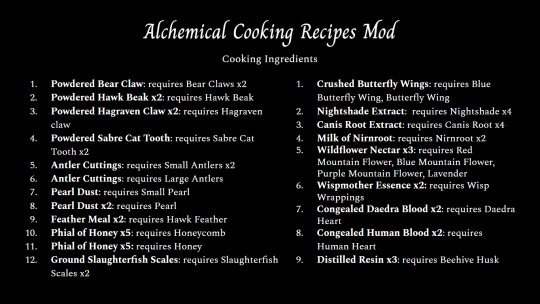



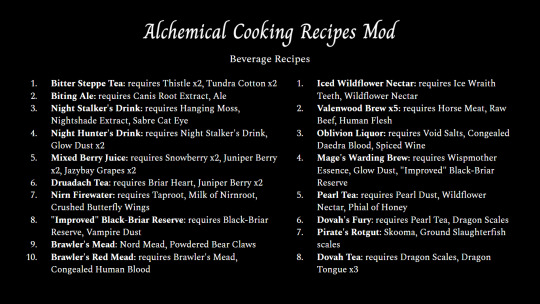
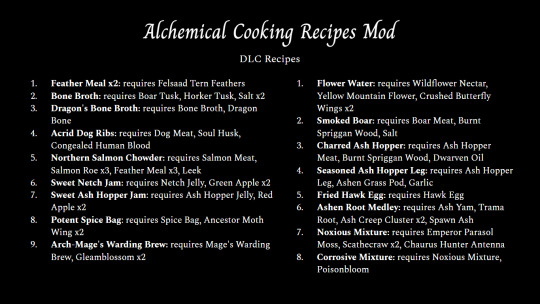
Alchemical Cooking Recipes mod for Skyrim Special Edition
Xbox Mod Nexus
~This is not my mod that I created, but I love it so much that I want to make a guide on it and hope that people will see it and download it. This mod goes great with the Frostfall: Hypothermia Camping Survival mod by Chesko as it provides recipes to combat hypothermia. All of this information is copied from the details of the mod page. - Admin: AssassinWriter~
Description:
Alchemical Cooking Recipes is meant to give characters who do not utilize alchemy a greater reason to harvest alchemical ingredients and a provide a fair supplement to those that do. Every ingredient was given a purpose and is used as a direct or indirect cooking ingredient for new foods and drinks. Generally, the type and strength of the magic effects provided by the new items were determined by the original effects associated with one or more alchemy ingredients used, the availability of the ingredients, and how complex the recipe was. However, some items have custom effects that provide unique benefits when consumed.
How do I cook these new foods and drinks?
You will need to visit the Alchemist's Shack on the edge of the Rift. You will find a nearby campfire and cooking pot with an alchemical cookbook resting on a stump. Reading this book will offer you the option to memorize the new cooking recipes and add them to your cooking menu. If at any point you wish to remove the recipes from the menu, you will need to return to the shack and read the book again to forget everything you learned. The cookbook also offers the ability to activate a Smart Menu feature so that items will only appear in your cooking menu when you have a notable ingredient for a recipe in your inventory. Cooking ingredients added by ACR will always appear in the menu even if the Smart Menu feature is active due to some recipes relying on them to be in your inventory to appear.
***Alternatively, you can enter via console 'set ACRGlobalRecipeToggle to 1' to add all the items to the cooking menu or 'set ACRGlobalRecipeToggle to 0' to remove them.
Entering 'set ACRGlobalSmartMenuToggle to 1' will activate the Smart Menu feature and ''set ACRGlobalSmartMenuToggle to 0' will deactivate it.
Original Creator Reuploader
COOKING INGREDIENTS:
Powdered Bear Claw: requires Bear Claws x2
Powdered Hawk Beak x2: requires Hawk Beak
Powdered Hagraven Claw x2: requires Hagraven claw
Powdered Sabre Cat Tooth: requires Sabre Cat Tooth x2
Antler Cuttings: requires Small Antlers x2
Antler Cuttings: requires Large Antlers
Pearl Dust: requires Small Pearl
Pearl Dust x2: requires Pearl
Feather Meal x2: requires Hawk Feather
Phial of Honey x5: requires Honeycomb
Phial of Honey x5: requires Honey
Ground Slaugherfish Scales: requires Slaughterfish Scales x2
Crushed Butterfly Wings: requires Blue Butterfly Wing, Butterfly Wing
Nightshade Extract: requires Nightshade x4
Canis Root Extract: requires Canis Root x4
Milk of Nirnroot: requires Nirnroot x2
Wildflower Nectar x3: requires Red Mountain Flower, Blue Mountain Flower, Purple Mountain Flower, Lavender
Wispmother Essence x2: requires Wisp Wrappings
Congealed Daedra Blood x2: requires Daedra Heart
Congealed Human Blood x2: requires Human Heart
Distilled Resin x3: requires Beehive Husk
FOODS:
Skooma: requires Moonsugar x2
Honey: requires Honeycomb
Bread: requires Wheat x3
Roasted Abecean Longfin: requires Abecean Longfin
Braised River Betty: requires River Betty
Blackened Cyrodilic Spadetail: requires Cyrodilic Spadetail
Seared Silverside Perch: requires Silverside Perch
Grilled Hiscarp: requires Histcarp
Steamed Mudcrab Claw: requires Mudcrab Chitin
Root Medley: requires Potato, Gourd, Creep Cluster x2, Canis Root Extract
Honey Bread: requires Wheat x3, Phial of Honey
Hunter's Stew: requires Skeever Tail, Antler Cuttings, Feather Meal, Potato, Tomato
Egg White Dish: requires Chicken Egg, Pine Thrush Egg, Rock Warbler Egg
Pheasant Dumpling: requires Pheasant Breast, Bleeding Heart, Lavender, Wheat x3
Chicken Stuffed Gourd: requires Chicken Breast, Gourd, Carrot, Leek, Scaly Mushroom, White Cap
Trapper's Gumbo: requires Pheasant Breast, Rabbit Meat, Carrot, Potato, Feather Meal
Herb Baked Horker: requires Horker Meat, Grass Pod, Blue Mountain Flower, Elves Ear
Chicken Hawk Soup: requires Chicken Breast, Powdered Hawk Beak, Canis Root Extract, Garlic, Potato
Skeever Jerky: requires Charred Skeever Hide, Salt x2
Eastmarch Apple Cobbler: requires Red Apple x2, Dragon Tongue x2, Wheat x4
Bug Soup: requires Blue Dartwing, Orange Dartwing x2, Torchbug Thorax, Bee, Crushed Butterfly Wings
Lunar Jelly: requires Luna Moth Wing x2, Moonsugar, Distilled Resin
Marshland Soup: requires Fungalpod x2, Giant Lichen x2
Roasted Mushrooms: requires Mora Tapinella, Scaly Pholiota
Creamy Mushroom Soup: requires Whitecap x2, Fly Amanita x2, Imp Stool x2
Seasoned Vegetable Soup: requires Vegetable Soup, Blue Mountain Flower, Red Mountain Flower
Nordic Clam Chowder: requires Clam Meat x2, Slaughterfish Egg, Nordic Barnacal, Ground Slaugherfish Scales
Spriggan Syrup: requires Spriggan Sap, Moon Sugar, Distilled Resin
Spicy Venison Stew: requires Venison Stew, Fire Salts
Cavedweller Pudding: requires Glowing Mushroom x3, Charus Eggs x3
Chilled Egg Custard: requires Chicken Egg x2, Frost Salt x2, Frost Mirriam
Giant's Fondue: requires Mammoth Cheese Bowl x2, Biting Ale, Powdered Mammoth Tusk
Scorched Goat Leg: requires Leg of Goat, Dwarven Oil
Hunter's Goulash: requires Venison, Potato x2, Antler Shavings x2
Hunter's Mighty Goulash: requires Hunter's Goulash, Eye of Sabre Cat x2, Powdered Sabre Cat Tooth, Powdered Bear Claw
Sweet Glazed Rabbit: requires Rabbit Meat, Phial of Honey, Distilled Resin
Witches Slop: requires Powdered Hagravan Claw, Hagraven Feathers, Namira's Rot, Blisterwort
Witches Vile Slop: requires Witches Slop, Deathbell x2, Nightshade Extract, Ectoplasm
Spicy Skeever Jerky: requires Charred Skeever Hide, Fire Salts x2
Repugnant Gruel: requires Troll Fat, Falmer Ear x2, Giant Toe, Spider Egg
Bloodmoon Pie x5: requires Human Flesh, Luna Moth Wing x2, Congealed Human Blood, Bone Meal x2
Spectral Bonemeal Paste: requires Ectoplasm, Distilled Resin, Bone meal x5
Fried Chicken Egg: requires Chicken Egg
Fried Pine Thrush Egg: requires Pine Thrush Egg
Fried Rock Warbler Egg: requires Rock Warbler Egg
Spice Bag: Elves Ear x2, Crimson Nirnroot, Crushed Butterfly Wings x2
BEVERAGES:
Bitter Steppe Tea: requires Thistle x2, Tundra Cotton x2
Biting Ale: requires Canis Root Extract, Ale
Night Stalker's Drink: requires Hanging Moss, Nightshade Extract, Sabre Cat Eye
Night Hunter's Drink: requires Night Stalker's Drink, Glow Dust x2
Mixed Berry Juice: requires Snowberry x2, Juniper Berry x2, Jazybay Grapes x2
Druadach Tea: requires Briar Heart, Juniper Berry x2
Nirn Firewater: requires Taproot, Milk of Nirnroot, Crushed Butterfly Wings
"Improved" Black-Briar Reserve: requires Black-Briar Reserve, Vampire Dust
Iced Wildflower Nectar: requires Ice Wraith Teeth, Wildflower Nectar
Valenwood Brew x5: requires Horse Meat, Raw Beef, Human Flesh
Oblivion Liquor: requires Void Salts, Congealed Daedra Blood, Spiced Wine
Mage's Warding Brew: requires Wispmother Essence, Glow Dust, "Improved" Black-Briar Reserve
Pearl Tea: requires Pearl Dust, Wildflower Nectar, Phial of Honey
Dovah's Fury: requires Pearl Tea, Dragon Scales
Pirate's Rotgut: Skooma, Ground Slaughterfish scales
Brawler's Mead: Nord Mead, Powdered Bear Claws
Brawler's Red Mead: requires Brawler's Mead, Congealed Human Blood
Dovah Tea: requires Dragon Scales, Dragon Tongue x3
DLC RECIPES:
Feather Meal x2: requires Felsaad Tern Feathers
Bone Broth: requires Boar Tusk, Horker Tusk, Salt x2
Dragon's Bone Broth: requires Bone Broth, Dragon Bone
Acrid Dog Ribs: requires Dog Meat, Soul Husk, Congealed Human Blood
Northern Salmon Chowder: requires Salmon Meat, Salmon Roe x3, Feather Meal x3, Leek
Sweet Netch Jam: requires Netch Jelly, Green Apple x2
Sweet Ash Hopper Jam: requires Ash Hopper Jelly, Red Apple x2
Potent Spice Bag: requires Spice Bag, Ancestor Moth Wing x2
Arch-Mage's Warding Brew: requires Mage's Warding Brew, Gleamblossom x2
Flower Water: requires Wildflower Nectar, Yellow Mountain Flower, Crushed Butterfly Wings x2
Smoked Boar: requires Boar Meat, Burnt Spriggan Wood, Salt
Charred Ash Hopper: requires Ash Hopper Meat, Burnt Spriggan Wood, Dwarven Oil
Seasoned Ash Hopper Leg: requires Ash Hopper Leg, Ashen Grass Pod, Garlic
Fried Hawk Egg: requires Hawk Egg
Ashen Root Medley: requires Ash Yam, Trama Root, Ash Creep Cluster x2, Spawn Ash
Noxious Mixture: requires Emperor Parasol Moss, Scathecraw x2, Chaurus Hunter Antenna
Corrosive Mixture: requires Noxious Mixture, Poison bloom
#skyrim#skyrim mods#skyrim recipe mods#recipes#food#alchemical#alchemical cooking recipes#the elder scrolls#admin: assassinwriter
9 notes
·
View notes
Text
wc prefixes and suffixes
prefixes: Acorn, Adder, Alder, Aloe, Amber, Ant, Apple, Ash, Ashen, Aspen, Auburn, Babble, Badger, Barley, Basil, Bat, Bay, Bear, Beaver, Beech, Bee, Beetle, Berry, Birch, Bird, Black, Blaze, Blizzard, Bloom, Blossom, Blue, Bluebell, Blueberry, Bone, Borage, Boulder, Bounce, Bracken, Bramble, Brave, Breeze, Briar, Bright, Brindle, Bristle, Broken, Brook, Brown, Brush, Bubble, Bumble, Burning, Burn, Buzzard, Buzz, Cave, Cedar, Cherry, Chestnut, Chirp, Chive, Cinder, Claw, Clay, Clear, Cliff, Cloud, Cloudy, Clove, Clover, Coal, Cold, Copper, Cotton, Creek, Cricket, Crooked, Crouch, Crow, Cypress, Daisy, Dandelion, Dapple, Dappled, Dark, Dawn, Dead, Deer, Dew, Doe, Dove, Downy, Drift, Drizzle, Duck, Dune, Dusk, Dust, Dusty, Eagle, Ebony, Echo, Eel, Elder, Elm, Ember, Elk, Falcon, Fallen, Falling, Fallow, Fawn, Feather, Fennel, Fern, Ferret, Finch, Fire, Fish, Flame, Flare, Flash, Fleet, Flint, Flood, Flower, Flurry, Fog, Forest, Fox, Freckle, Frog, Frost, Frozen, Gentle, Ginger, Golden, Goose, Gorge, Gorse, Grass, Green, Grey, Grizzled, Grouse, Gull, Gust, Hail, Half, Hare, Haven, Hawk, Hay, Hazel, Heather, Heavy, Hemlock, Heron, Hickory, Hill, Hive, Hollow, Holly, Honey, Hop, Hornet, Hound, Hush, Ice, Icy, Iris, Ivy, Jagged, Jay, Jump, Juniper, Kestrel, Kindle, Kink, Lake, Larch, Lark, Laurel, Lavender, Leaf, Leopard, Lichen, Light, Lightning, Lilac, Lily, Lion, Little, Lizard, Long, Lost, Loud, Lynx, Mallow, Maple, Marigold, Marsh, Meadow, Minnow, Mint, Missing, Mist, Mistle, Misty, Mole, Morning, Moss, Mossy, Moth, Mottle, Mottled, Mountain, Mouse, Mud, Muddy, Mumble, Myrtle, Needle, Nettle, Newt, Night, Nut, Oak, Oat, Ocean, Odd, Olive, One, Orchid, Osprey, Otter, Owl, Pale, Parsley, Patch, Peach, Pear, Pearl, Pebble, Perch, Petal, Pheasant, Pigeon, Pike, Pine, Pink, Plum, Pond, Pool, Poppy, Pounce, Prickle, Puddle, Quail, Quick, Quiet, Rabbit, Ragged, Raccoon, Rain, Rat, Raven, Red, Reed, Ripple, Rising, River, Robin, Rock, Root, Rose, Rowan, Rubble, Running, Rush, Russet, Rust, Rusty, Rye, Sage, Sand, Sandy, Sap, Scorch, Scratch, Sea, Sedge, Seed, Shade, Shadow, Sharp, Sheep, Shell, Shining, Shore, Short, Shred, Shrew, Shrub, Shy, Silent, Silk, Silver, Skip, Skunk, Sky, Slate, Sleet, Slush, Small, Smoke, Smudge, Snag, Snail, Snake, Snow, Soft, Song, Soot, Sorrel, Spark, Sparrow, Speckled, Speckle, Spider, Splash, Splinter, Spotted, Spring, Spruce, Squirrel, Stag, Starling, Stoat, Stone, Stork, Storm, Stream, Striped, Stumpy, Sun, Sunny, Swallow, Swan, Sweet, Swift, Tabby, Tall, Talon, Tangle, Tansy, Tawny, Thistle, Thorn, Thrush, Thunder, Thyme, Tiger, Timber, Tiny, Toad, Torrent, Torn, Tortoise, Trout, Tulip, Tumble, Turtle, Twig, Twilight, Valley, Velvet, Vine, Violet, Viper, Vole, Vulture, Wasp, Water, Wave, Weasel, Web, Weed, White, Wild, Willow, Wind, Wolf, Wren, Yarrow, Yellow, Yew
suffixes: adder, ant, apple, ash, aspen, babble, bark, beam, bee, belly, berry, bite, bird, blaze, bloom, blossom, blotch, bounce, bramble, briar, branch, breeze, briar, bright, brook, bud, burn, burr, bush, call, chaser, catcher, cherry, chive, cinder, claw, cloud, clover, cough, crawl, creek, crest, crow, cry, curl, current, daisy, dance, dapple, dawn, drop, dove, dusk, dust, ear, echo, eye, eyes, face, fall, fallow, fang, feather, fern, field, fire, flake, flame, flare, flash, flight, flood, flower, flurry, fox, foot, freckle, frond, frost, fur, gaze, gleam, grass, grove, gorse, hail, hare, hawk, haze, heart, heather, holly, hop, hush, ice, iris, ivy, jay, jaw, jump, leaf, kelp, kestrel, lake, larch, lark, lavender, leaf, leap, leg, lichen, light, lilac, lily, lion, lizard, lotus, mallow, marsh, mask, meadow, mint, mist, moss, moth, mouse, murmur, needle, nettle, nose, nut, oak, oat, olive, patch, path, pelt, perch, petal, pigeon, pool, pond, poppy, pounce, puddle, quail, quill, rain, rat, raven, rapid, reed, ridge, ripple, rise, river, root, rose, rubble, runner, rush, sage, sand, scar, screech, sedge, seed, shade, shadow, shell, shine, sight, skip, sky, slate, slip, smoke, snow, song, soot, sparrow, spark, speck, speckle, splash, spot, spots, spring, stalk, step, stem, sting, stone, storm, stream, streak, stride, strike, stripe, stone, sun, swipe, swoop, tail, talon, thicket, thistle, thorn, throat, thunder, trail, tooth, tuft, tumble, vine, vole, water, watcher, weed, whisker, willow, wind, wing, wish, whisper
38 notes
·
View notes
Text
BOG FROGS
hi! i don’t usually post my writing, but i wrote this short story the other day and i’m super proud of it, so i’m gonna post it here!
The cloudy evening sky framed the infinite dull expanse of peat and mud in the bog. For miles there was nothing but the small underbrush and scattered patches of moss and grasses. Sprigs of asphodel shot up from the soggy soil, their six-pointed yellow flowers seemingly hopeful in the dreary olive landscape. Fine leafed brush and the sticky hands of sundews scattered the edges of puddles and streams that ran through the plain, water fleas and beetles lurking in the muddy depths between the twisting tendrils of aquatic moss.
Hidden in the grass frogs sang their songs perfectly out of sync, each tune overlapping the tune of another. Their deep bellows and creaks echoed across the bog from all directions, the effect of standing in the center of a roaring orchestra at the time of tuning. The only suggestion of their physical presence: two eyes peering out from the peat, golden and glistening like polished coins in sunlight. Amongst the din of the frog song, dragonflies buzzed harshly in the bush, and the distant song of the red grouse warns.
Daylight slowly fades as the sun makes its course across the sky, draping the land in baleful darkness. The eyes of the frogs still shine like fireflies in the night, peaking through the tallgrass in the bog and flickering as they blinked. In the distance the glow of a gas lantern comes into view, rocking to-and-fro with the gentle breeze, beckoning. Upon closer inspection the land forms an upward slope like a burial mound, topped with mismatched patches of moss and deer sedge grass like a crude roof. The sides of the structure are compacted peat and clay to form walls, a small hole on one side covered in woven twine acting as a window. The bark of a fallen tree rests in the center of the wall used as a door.
Adorning the perimeter is a plot of delicate flowers, mosses, and lichen in no particularly organized fashion, but clearly intentionally placed. Among them the violet flowers of the purple moor, sprigs of bog cotton, branching tormentil, and the spiraling growths of red sphagnum moss. Some of these growths overlap onto the roof of the house, completely concealing the structure in the native growth. The lantern continues to sway like the pendulum of a clock, enticing to come nearer. The song of the red grouse echoes across the bog.
Closer, the detail of the house becomes clearer. Moss and lichen grows up the sides of the peat walls, giving visual texture to the seemingly plain, muddied walls. On the left side of the plot, there is a small pool of tannin-stained water hosting multiple frog spawns and the writhing bodies of earthworms. Flies buzz along the roof of the house, being consequently captured by the oozing fingers of sundews to be decomposed over the course of days. The smell of carrion was wafting from the muddy hut, like a thick sludge hanging in the air. Again, the lone red grouse calls out into the infinite darkness. The lantern glimmers in the night, surrounded by flying moths and mosquitoes.
The bark door tips to the ground, revealing the inside of the shelter. Hundreds of frogs huddled together in a circle on the ground, some climbing onto each other in their cramped conditions, with one hulking large frog in the center. Their bodies were pressed so closely together in one slimy mass they almost appeared as one, squirming and hopping in the dark house. Glowing orbs of yellow blinked from every inch of the room, like twinkling stars in the black tar of the sky. While the lot of them were on the ground surrounding the one large frog, others clung to the walls, some sat atop the molded mud tables, a few inside clay pottery scattered across the floor.
From the center of the circle, the large frog lets out a roaring bellow, its vocal sac vibrating with its intensity. In unison, the rest of the frogs in the hut begin to chirp and creak, the sound almost deafening. The waves of sound radiated for miles, reaching every inch of the landscape. Outside the house, the bog is cloaked in a dark blanket of night; no glowing yellow eyes, no buzzing flies, no red grouse. Only the bellowing of the frogs and the sticky sound of their bodies hopping into the shallow mud, enveloping themselves in the sludge. The last to remain in the mud structure was the large frog, its shining yellow eyes bulging from its head and staring blankly into the dark room.
2 notes
·
View notes